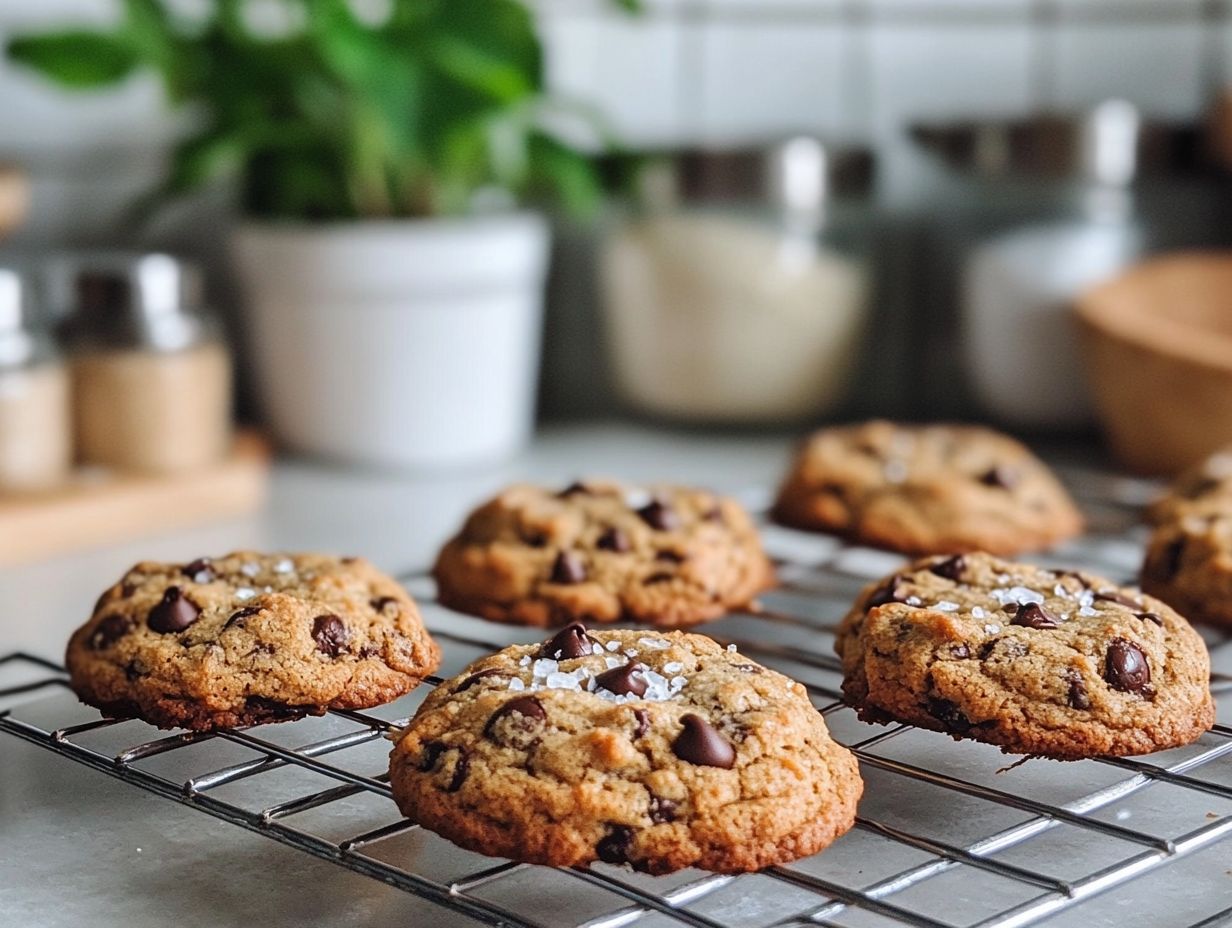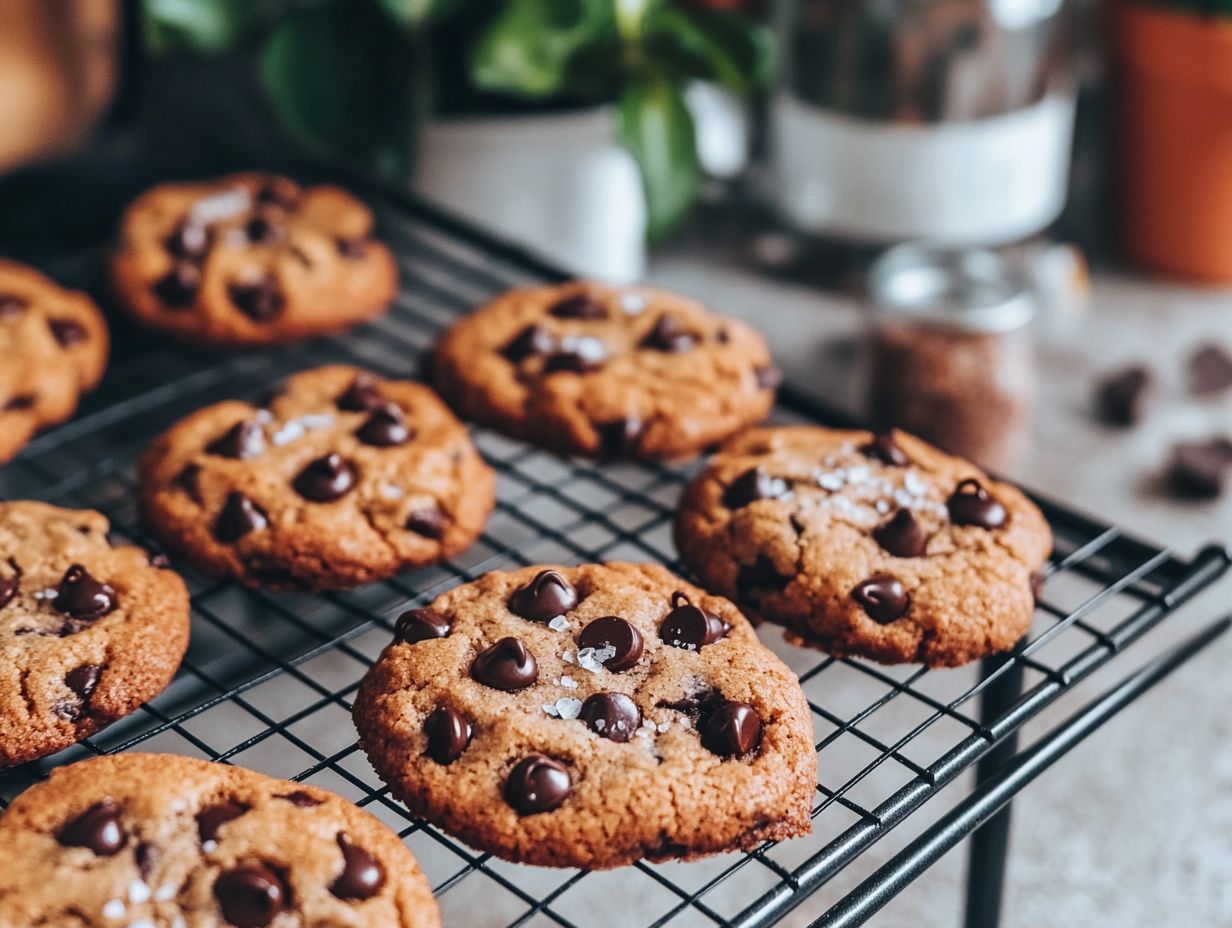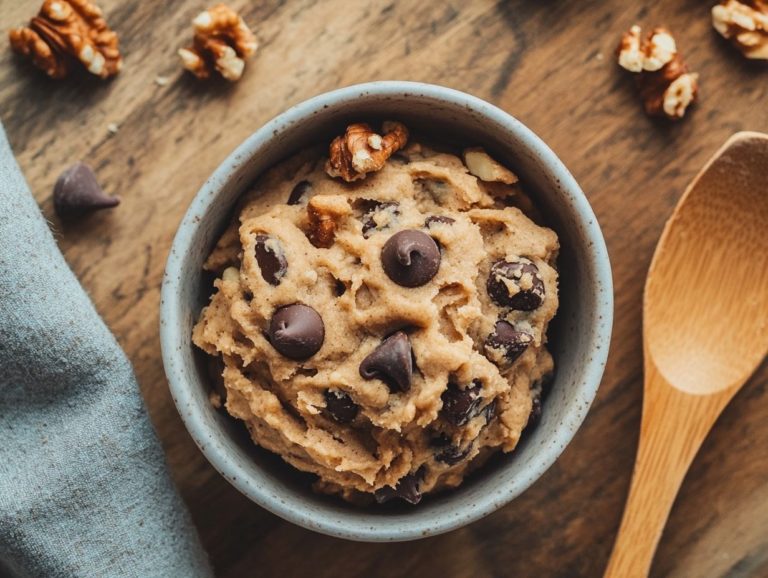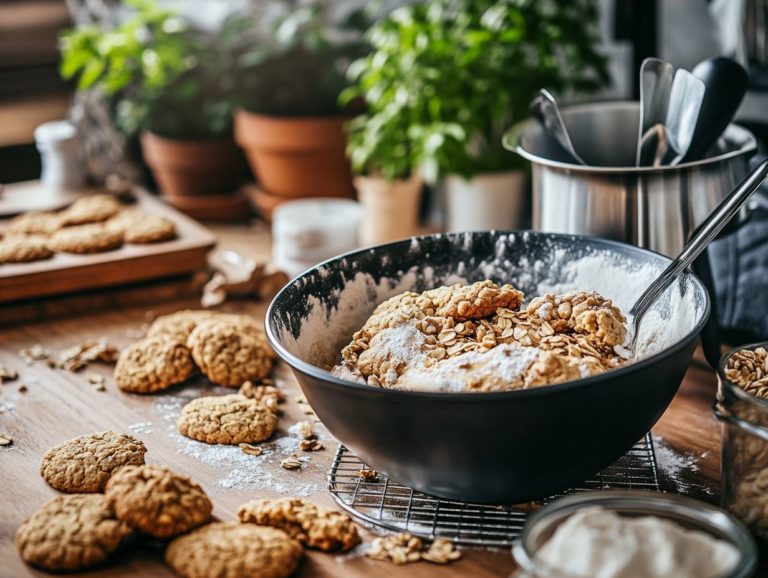Plant-Based Cookies: Best Practices for Baking
Curious about the enticing realm of vegan cookies? These delightful treats provide a flavorful and healthier alternative to their traditional counterparts, making them the ideal choice for anyone eager to indulge in sweets without animal products.
This article delves into the benefits of plant-based cookies, the ingredients that elevate them, and the best practices for baking your own vegan cookies. From selecting the perfect substitutes to enhancing nutrition and steering clear of common pitfalls, you ll uncover everything necessary to whip up batch after batch of delightful, guilt-free cookies.
Contents
- Tips for Baking Plant-Based Cookies
- Elevate Your Plant-Based Cookies
- How Can You Make Plant-Based Cookies More Nutritious?
- What Are Some Common Mistakes When Baking Plant-Based Cookies?
- What Are Some Delicious Plant-Based Cookie Recipes?
- Frequently Asked Questions
- What are plant-based cookies?
- Why should I bake plant-based cookies?
- What are some key ingredients for baking plant-based cookies?
- What is the best way to achieve a chewy texture in plant-based cookies?
- What are some tips for substituting ingredients in traditional cookie recipes for plant-based options?
- Can I freeze plant-based cookie dough?
Key Takeaways:

- Consider using an oven thermometer to maintain the correct baking temperature for perfect cookies.
- Plant-based cookies offer a variety of health benefits, including being cholesterol-free and rich in nutrients.
- Common substitutes for animal products in plant-based cookies can include applesauce, flaxseed, and coconut oil, which can affect the texture and flavor of the cookies.
- To ensure delicious and nutritious plant-based cookies, use alternative flours, natural sweeteners, and add protein and whole foods to the recipe. Focus on precise baking techniques for the best results.
What Are Plant-Based Cookies?
Plant-based cookies offer a delightful and delicious alternative to traditional cookies, crafted entirely from plant-derived ingredients. They are a perfect choice for anyone following a plant-based diet. Whether you’re a beginner or a seasoned baker, vegan baking books can provide extensive insights into making these cookies.
By swapping out animal products for vegan-friendly options, you can whip up an impressive array of treats, from classic chocolate chip cookies to sweet sugar cookies, without compromising on flavor or texture. Flax eggs, made by mixing ground flaxseed with water, and coconut milk are fantastic examples of how to achieve this.
These cookies often feature ingredients like vegan butter, coconut milk, and natural sweeteners. This provides a guilt-free indulgence that appeals to both health-conscious eaters and dessert enthusiasts alike.
With a wide range of cookie recipe inspirations available, you ll find it easy to explore various flavors, ensuring there s something to satisfy everyone’s palate.
What Are the Benefits of Plant-Based Cookies?
Plant-based cookies bring a wealth of benefits, perfectly suited for a range of dietary preferences. They are especially great for those embracing a healthier lifestyle or on the lookout for delectable vegan dessert options. These cookies fit seamlessly into the rising awareness of nutrition and health.
This makes them ideal for cookie swaps, festive gatherings, and any occasion where everyone can indulge without compromising on their dietary choices. With wholesome ingredients at their core, plant-based cookies can be both indulgent and nourishing, appealing to a broad audience.
The allure of these delightful treats goes beyond just health benefits; they are an inclusive option. Being free from common allergens like dairy and eggs, they accommodate various dietary restrictions with ease. Whether you’re celebrating birthdays, holidays, or enjoying casual get-togethers, plant-based cookies offer a delightful solution.
This ensures that no one feels left out when dessert time arrives. Their versatility allows for the incorporation of superfoods like chia seeds, oats, and nuts. This results in mouthwatering flavor combinations that satisfy your sweet cravings while promoting overall wellness.
With the growing trend toward sustainable eating, these cookies resonate with environmentally conscious consumers who appreciate eco-friendly practices. They make for a smart and satisfying choice for any occasion. Start your baking journey today and experience the joy of delicious, guilt-free cookies!
What Ingredients Are Used in Plant-Based Cookies?
The secret to creating delectable plant-based cookies lies in your choice of ingredients, which should not only replace traditional animal products but also elevate both flavor and texture. Opt for high-quality vegan butter and coconut cream to enhance the richness of your cookies.
Consider using vegan butter as a substitute for regular butter, while coconut milk adds a delightful creaminess. Flax eggs made by mixing ground flaxseed with water serve as an excellent egg replacement, ensuring your cookies have the right binding and richness. For those looking for a dairy-free alternative, these choices are excellent.
Don t overlook the importance of various plant milk options, baking powder, and sweeteners like caster and brown sugar they re essential for achieving your desired cookie texture, whether you crave crispy edges or soft, chewy centers. And of course, chocolate chips are an indulgent mix-in that remains a perennial favorite in countless recipes. Using a wooden spoon for mixing these ingredients can help blend them more evenly.
What Are Some Common Substitutes for Animal Products?
Vegan baking offers many popular substitutes for animal products that ensure you can enjoy delicious cookies without compromising your dietary choices. These innovative alternatives not only cater to your plant-based lifestyle but also introduce unique flavors and textures to your baked goods.
For instance, you can swap traditional shortening for coconut oil, which adds a subtle sweetness and richness to your dough while boasting a healthier fat profile. Nut butters, like almond or peanut butter, serve a dual purpose by infusing flavor and moisture into your cookies, making them both chewy and satisfying. The growing popularity of plant-based milks, such as almond or oat milk, has expanded your options for achieving the desired creaminess, enhancing the overall taste experience of these delectable treats. Whether you’re using chickpea blondies or traditional cookie recipes, these substitutes add unique flavors and textures.
Together, these ingredients show that vegan baking isn t just a fleeting trend; it offers a refreshing take on classic recipes, allowing you to indulge in guilt-free snacking.
How Do These Substitutes Affect the Texture and Flavor of the Cookies?
The use of substitutes in your plant-based cookies can significantly influence their texture and flavor, enabling you to craft a delightful range of cookie experiences from chewy to those with perfectly crispy edges. Choosing between whipped butter and melted butter affects the cookie’s structure. Tools like a measuring scale can help you get the right proportions for these ingredients.
Using various baking techniques can enhance flavors and textures, giving you even more creative control. This flexibility allows you to explore a myriad of cookie flavors, ensuring each batch is uniquely tailored to your tastes.
For example, when you incorporate ingredients like applesauce or nut butters as substitutes for traditional fats, you not only alter the moisture content but also introduce a distinctive taste profile that can elevate the overall experience. Experimenting with different types of flours such as almond or coconut flour can yield intriguing textures, whether you prefer denser, cake-like cookies or lighter, crispier ones. Understanding baking ratios is crucial to getting these textures right.
Chilling the dough before baking helps prevent spreading, resulting in thicker, more satisfying cookies that beautifully capture the nuances of your chosen flavors.
These adjustments highlight the creative possibilities within plant-based baking, allowing you to cater to various dietary needs without compromising on taste. Comprehensive cookie guides and recipe testing can offer deeper insights into achieving the best results. Don t miss out on the chance to transform your baking with these delicious plant-based options!
Tips for Baking Plant-Based Cookies
What Are Some Tips for Baking Plant-Based Cookies?

Baking plant-based cookies is simple with a few key tips. These tips can elevate your cookie-making experience.
Begin by measuring your ingredients precisely. Use a tool that helps you weigh ingredients accurately for the best ratios. Tools like an oven thermometer and a cooling rack are also invaluable for achieving the perfect bake.
When combining the ingredients in a mixing bowl, take your time to blend them thoroughly. This step is essential for creating a cohesive cookie dough. Pay close attention to baking time and temperature, as these factors are vital for that perfect cookie.
Use an oven thermometer to ensure even baking. This will help your cookies bake evenly and develop the ideal texture you crave.
How Does the Type of Flour Affect the Cookies?
The type of flour you choose can significantly influence the final texture, flavor, and nutritional profile of your treats. Each variety brings its unique characteristics to the mix.
While all-purpose flour is a popular choice for its versatility, feel free to get creative and experiment with whole wheat flour. This can add a delightful nuttiness and boost the fiber content of your cookies.
Understanding the right baking ratios for different flour types is crucial. This helps in striking the perfect balance between achieving a chewy cookie and maintaining structure.
If you opt for bread flour, with its higher protein content, your cookies will have a chewy and robust texture ideal for those who enjoy a heartier bite.
Conversely, gluten-free options like almond or coconut flour introduce distinctive flavors, catering wonderfully to those with dietary restrictions. Testing recipes with these flours can yield surprising and delightful results.
Each type of flour interacts uniquely with liquids, fats, and sugars in your recipe, shaping not just the texture but enhancing the overall flavor. By thoughtfully adjusting the type of flour, you can elevate your cookies from mere snacks to a complex and delightful experience.
For further guidance, consulting vegan baking books will provide valuable tips and techniques.
What Are Some Alternatives to White Sugar?
When you’re looking to sweeten your plant-based cookies, many alternatives to white sugar can enhance sweetness while introducing unique flavors and textures.
While options like cane sugar, brown sugar, and caster sugar are tried and true, natural sweeteners such as coconut sugar can provide a more complex taste profile.
Each alternative has distinct baking properties, so it s essential to understand how they interact with other ingredients for that perfect balance in your recipes.
For example, maple syrup adds rich, earthy sweetness and moisture. You may need to adjust the liquid content in your dough to accommodate it. Agave nectar boasts a mild flavor that blends effortlessly into cookie batters.
Then there s date sugar, which comes from dehydrated dates and adds a delightful caramel-like sweetness. However, it doesn t dissolve easily, which could influence your cookies’ final texture.
By experimenting with these alternatives, you can craft delicious plant-based cookies that satisfy a range of tastes while keeping things on the healthier side.
Get started on your baking journey today and enjoy delicious, healthy cookies!
Elevate Your Plant-Based Cookies
How Can You Add Protein to Plant-Based Cookies?
Incorporating protein into your plant-based cookies can significantly enhance their nutrition value, making them more satisfying and beneficial for anyone looking to up their protein intake. You can seamlessly add options like plant-based protein powder, nut butters, or even mashed chickpeas to your cookie dough for that extra protein boost.
These ingredients not only nourish but also enrich the overall texture and flavor of your cookies. This opens the door to a world of creative and healthy mix-ins.
If you’re feeling adventurous, experimenting with ingredients like flaxseeds or chia seeds can introduce a delightful crunch. These seeds boost the protein content, thanks to their abundant omega-3 fatty acids and fiber.
For the chocolate lovers among you, adding cocoa nibs or dark chocolate chunks can elevate the taste experience without sacrificing health benefits.
By adopting whole grain flours such as chickpea or almond flour, you can significantly improve the nutritional value of your cookies. Embracing these versatile ingredients allows you to create cookies that are not only deliciously indulgent but also support a more balanced approach to snacking.
How Can You Make Plant-Based Cookies More Nutritious?
To elevate the nutritional profile of plant-based cookies, you can seamlessly incorporate whole foods and nutrient-dense ingredients that deliver both exquisite flavor and significant health benefits.
By introducing fiber-rich components like oats or ground flaxseeds, you can transform your cookies from mere sweet indulgences into truly wholesome delights. Healthy fats from nuts or seeds add even more benefits.
This thoughtful approach not only satisfies your cravings but also bolsters your overall health and wellness. You can enjoy delicious treats while ensuring that taste remains uncompromised.
What Nutrients Can Be Added to Plant-Based Cookies?
Incorporating specific nutrients into your plant-based cookies can elevate their health benefits, making them much more than just a sweet indulgence.
By adding ingredients like flaxseeds, which are abundant in omega-3 fatty acids, or oats for their soluble fiber, you can create baked goods that actively support heart health and digestion.
Nutritional yeast not only provides a delightful cheesy flavor but also boosts B vitamins, making it an excellent choice for anyone embracing a vegan lifestyle. Opting for natural sweeteners like maple syrup or agave enhances the flavor profile and introduces antioxidants to the mix.
With the addition of dried fruits such as goji berries or cranberries, your cookies can deliver a burst of phytonutrients and vitamins that support immune function and overall vitality. This ensures that each bite bursts with healthful goodness!
How Can You Incorporate Whole Foods into Plant-Based Cookies?

Incorporating whole foods into your plant-based cookies can significantly elevate their flavor, texture, and nutritional value. This transforms each bite into a more satisfying and healthful experience.
By thoughtfully selecting these ingredients, you can turn standard recipes into nutrient-dense treats that delight your palate while supporting your well-being. Whole foods like flaxseeds provide essential omega-3 fatty acids and serve as natural binders.
Coconut flakes introduce a delightful tropical flair along with extra fiber. Exploring various whole grains, such as quinoa or spelt flour, can enhance the protein profile of your cookies.
Consider playing with bittersweet dark chocolate chunks or almond butter to create indulgent flavor combinations that don’t sacrifice health benefits. By integrating such a diverse array of whole foods, your cookies can truly transform into a wholesome indulgence.
What Are Some Common Mistakes When Baking Plant-Based Cookies?
When you embark on the journey of baking plant-based cookies, it’s essential to be aware of common pitfalls that could compromise the final product, affecting both taste and texture.
One frequent misstep is improper cookie shaping. This can lead to uneven baking and less-than-desirable textures. Neglecting the recommended baking time and temperature may yield cookies that are either burnt or undercooked.
Utilizing a cooling rack is a crucial step. It allows your cookies to set properly after baking, preventing sogginess and ensuring they maintain their perfect consistency.
How Can You Avoid Dry or Crumbly Cookies?
Achieving the perfect cookie texture is essential. Steering clear of dry or crumbly cookies often hinges on finding the right balance of ingredients and moisture levels. Ensuring adequate fat content like using vegan butter or plant oils is crucial for crafting tender cookies.
Adjusting baking ratios to include sufficient liquid ingredients will help maintain that much-needed moisture. Incorporating elements like applesauce or aquafaba (the liquid from canned chickpeas used as an egg replacement) can add an extra layer of tenderness.
Experimenting with different types of flour can be quite effective. For instance, using all-purpose flour often yields a better texture than whole wheat, which tends to absorb more moisture.
Pay attention to the role of sugar in your recipe as well. Opting for brown sugar instead of white sugar helps retain moisture and contributes to a chewier consistency.
It s also vital to avoid overmixing the dough, as this can lead to tougher cookies. Keep a close eye on the baking time. Removing them from the oven just before they re fully set allows them to firm up while cooling, preventing that dreaded dry outcome.
What Can You Do to Prevent Flat Cookies?
Preventing flat cookies involves a few key strategies focused on maintaining the perfect cookie shape and ensuring that your ingredients interact harmoniously. One effective approach is to chill the dough before baking. This solidifies the fats and helps the cookies hold their shape throughout the baking process.
It s crucial to check the freshness of your baking powder and adjust the baking temperature, as these factors can significantly influence how your cookies rise and maintain their desirable thickness.
Careful measurement of flour is essential, since too little can lead to overly spread-out cookies. When measuring, use a spoon to lightly fluff the flour before scooping to ensure accuracy.
Another handy technique is to incorporate an extra egg yolk. This addition brings richness and moisture, contributing to a thicker cookie overall.
Consider opting for a higher ratio of brown sugar to granulated sugar. Not only does this enhance the flavor, but it also aids in moisture retention, resulting in a chewier texture that resists spreading.
How Can You Ensure Even Baking?
Ensuring even baking of your plant-based cookies is essential for achieving that delightful consistency in texture and flavor across every batch. Start by selecting a quality baking tray, which promotes uniform heat distribution.
An oven thermometer is also your best friend. It helps you verify that the baking temperature stays steady throughout the process. Flipping the cookies halfway through baking will further enhance that evenness, ensuring that each cookie is baked to perfection.
To elevate your baking experience, consider using silicone baking mats. They provide a non-stick surface and assist in heat regulation, making your life a bit easier.
Another effective technique is to space the cookies evenly on the tray, allowing proper airflow that contributes to even cooking. Don t forget to preheat your oven for at least 15-20 minutes; this ensures that the heat is evenly distributed before you place those delicious cookies inside.
For those who are truly passionate about baking, investing in a convection oven can be transformative. It circulates hot air, cooking your cookies evenly and reducing baking time, making your baking adventures even more enjoyable.
Conclusion
In summary, avoiding common mistakes while baking plant-based cookies can significantly improve your results. Remember to pay attention to ingredient balance, proper techniques, and cooking conditions. With these tips, you’ll love how easy it is to create the perfect cookie shape and texture! So get started and enjoy your baking journey!
What Are Some Delicious Plant-Based Cookie Recipes?
Whether you’re looking for cookie recipe inspiration or trying out new cookie baking techniques, these recipes are sure to delight your taste buds!
You ll discover a wealth of delectable plant-based cookie recipes that can inspire both novice and seasoned bakers alike. From timeless chocolate chip cookies to cheerful festive sugar cookies, there’s something for everyone. Whether you’re interested in baking cookies for a cookie swap or just for fun, you’ll find plenty of options!
Consider adding a creative twist, like utilizing chickpea blondies for an unexpected flavor experience. You can also infuse seasonal spices to elevate your cookie creations. Incorporate cookie mix-ins like chocolate chips or use vegan butter as a butter substitute to enhance the flavor.
This delightful diversity not only caters to a range of tastes but also allows you to present an impressive array of treats for festive events and gatherings. It ensures there’s something for everyone to enjoy. Perfect for those on a plant-based diet, these recipes offer delicious vegan dessert options.
Frequently Asked Questions

For more ideas, check out The Essential Book of Vegan Bakes by Toni Okamoto.
Plant-based cookies are made without any animal-derived ingredients, such as eggs or dairy. They are typically crafted using plant-based substitutes, like flax eggs or chia seeds, to achieve the same texture and flavor as traditional cookies.
Baking plant-based cookies is great for the environment and opens up a world of vegan baking possibilities!
It allows you to enjoy delicious treats without the use of animal products while reducing your environmental impact and supporting sustainable agriculture.
Earth Balance and Miyoko s are excellent options for vegan butter.
Key ingredients for baking plant-based cookies include plant milk like coconut milk or soy milk, vegan butter or oil, flax or chia seeds, and plant-based sweeteners such as maple syrup or dates. You can also use cane sugar or brown sugar for sweetness.
To maintain a chewy texture, using a cooling rack can help!
Avoid baking mistakes by using an oven thermometer to ensure accurate baking temperature. Ingredients like melted butter also aid in achieving a chewy texture.
To create chewy cookies, use a combination of plant-based fats (like vegan butter or coconut oil) and an ingredient that helps hold the mixture together, such as flax or chia seeds. Be careful not to overbake the cookies, and chilling dough before baking can help create a delightful chewy texture!
For added flavor, consider using coconut cream or whipped butter as substitutes!
Always conduct a recipe testing phase to find the best alternatives. For eggs, use 1 tablespoon of ground flax or chia seeds mixed with 3 tablespoons of water as an egg replacement. For butter, use equal parts of vegan butter or coconut oil. You can substitute any plant-based milk, such as almond milk, oat milk, or coconut milk.
Yes, you can freeze plant-based cookie dough for later use! Freezing is ideal for cookie swap events.
Simply scoop the dough onto a baking sheet and place it in the freezer until solid. Then transfer the frozen dough balls to a freezer-safe bag or container. When ready to bake, let the dough thaw in the fridge for a few hours before baking as usual. Freezing cookie dough allows you to have fresh cookies anytime!
Dive into these delicious plant-based cookie recipes and impress your friends and family!






